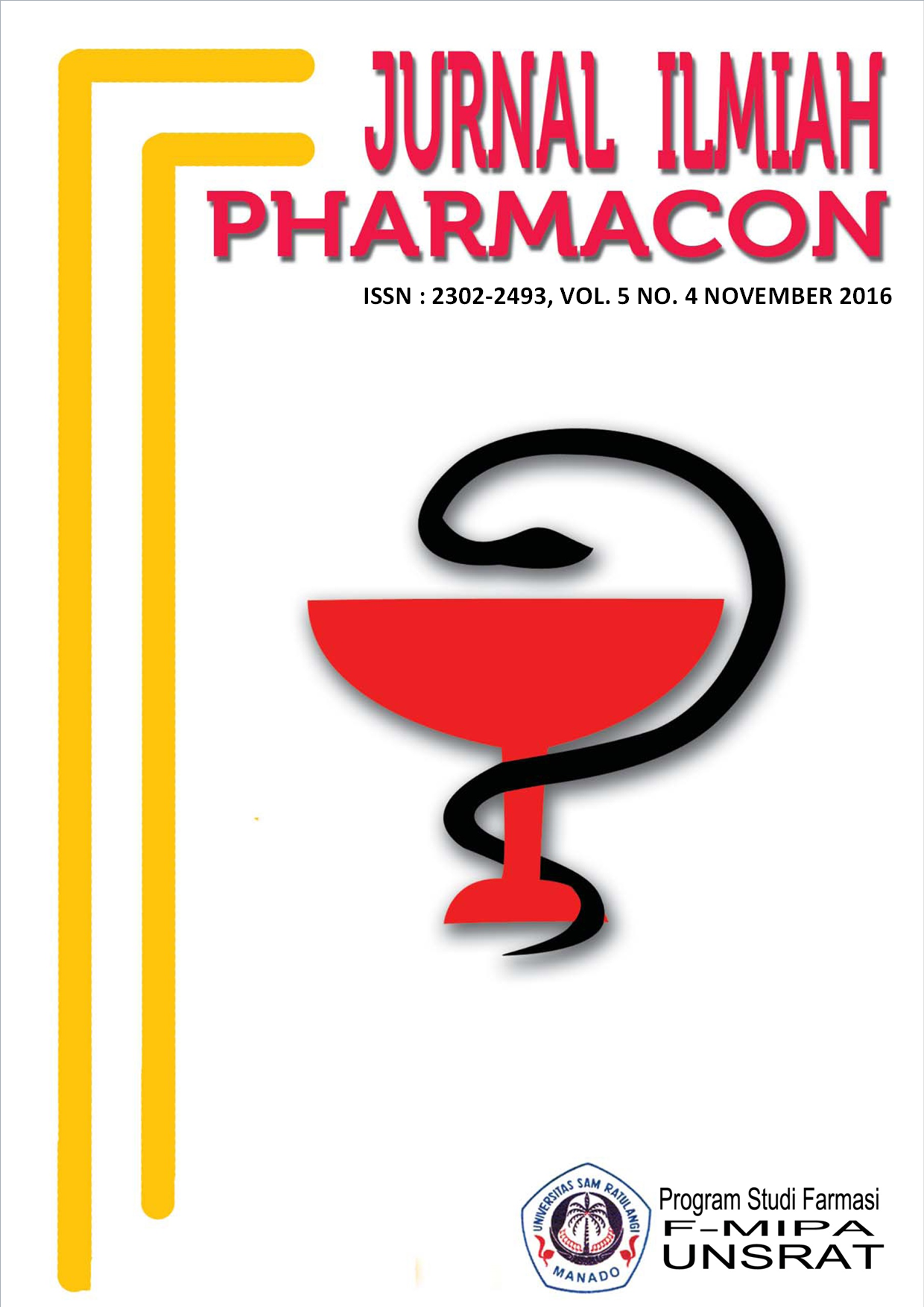UJI PENGARUH PENGGUNAAN PASTA GIGI DENGAN KANDUNGAN DETERGEN SODIUM LAURYL SULFATE TERHADAP KECEPATAN ALIR SALIVA PADA MASYARAKAT DI DESA WALANTAKAN
DOI:
https://doi.org/10.35799/pha.5.2016.13973Abstract
UJI PENGARUH PENGGUNAAN PASTA GIGI
DENGAN KANDUNGAN DETERGEN SODIUM LAURYL SULFATE TERHADAP KECEPATAN ALIR SALIVA PADA MASYARAKAT
DI DESA WALANTAKAN
Eoudia B. Wawo1), P.M. Wowor1), Krista V. Siagian1)
1)Program Studi Pendidikan Dokter Gigi Fakultas Kedokteran UNSRAT Manado, 95115
ABSTRACT
Saliva is a component in the oral cavity which has a major role in the oral cavity. Saliva secretions can be influenced by stimuli in the form of food, beverages, drugs and toothpaste. Toothpaste contains ingredients such as abrasive materials, moisturizers, fluoride, also foam generator materials or Sodium Lauryl Sulfate (SLS). SLS including the ingredients detergents anionik. Toothpaste that contain SLS many circulate in the market. Most people use toothpaste that contain detergents. The speed of the saliva flow chart have a great impact on the health of the mouth because the speed of the saliva flow chart slowly can cause the accumulation of remnants of food and related to the risk of dental caries and periodontal disease. The purpose of this research is to know the influence of the use of toothpaste detergents Sodium Lauryl Sulfate against the speed of the saliva flow chart on the community in the village of Walantakan. This research Quasi experimental research design with pre and post test with control group. Sample size as many as 42 samples by total populasi namely men and women aged 21-50 years and willing to become the subject of research by using the instrument measurement sheet saliva flow chart speed. The Data obtained using dianalisi test Paired T test. The research result show that there is a significant influence on the use of toothpaste with detergents sodium lauryl sulfate against the speed of the saliva flow chart be slow.
Keywords : toothpaste, Sodium Lauryl Sulfate, salivary flow rate
ABSTRAK
Saliva merupakan komponen dalam rongga mulut yang memiliki peran besar dalam rongga mulut. Sekresi saliva dapat dipengaruhi oleh stimulus berupa makanan, minuman, obat-obatan dan pasta gigi. Pasta gigi mengandung bahan seperti bahan abrasif, pelembab, fluoride, juga bahan pembuat busa atau Sodium Lauryl Sulfate (SLS). SLS termasuk dalam bahan detergen anionik. Pasta gigi yang mengandung SLS banyak beredar di pasaran. Masyarakat kebanyakan menggunakan pasta gigi yang mengandung detergen. Kecepatan alir saliva memiliki pengaruh yang besar terhadap kesehatan rongga mulut karena kecepatan alir saliva lambat dapat menyebabkan penumpukan sisa-sisa makanan dan berhubungan dengan resiko karies gigi dan penyakit periodontal. Tujuan penelitian ini untuk mengetahui pengaruh penggunaan pasta gigi detergen Sodium Lauryl Sulfate terhadap kecepatan alir saliva pada masyarakat di desa Walantakan. Penelitian ini merupakan penelitian Quasi eksperimental dengan desain penelitian pre and post test with control group. Besar sampel yaitu sebanyak 42 sampel diambil dari total populasi yaitu laki-laki dan perempuan usia 21-50 tahun dan bersedia menjadi subjek penelitian dengan menggunakan instrumen lembar pengukuran kecepatan alir saliva. Data yang diperoleh dianalisi menggunakan uji Paired T test. Hasil penelitian menunjukan bahwa ada pengaruh bermakna pada penggunaan pasta gigi dengan kandungan detergen sodium lauryl sulfate terhadap kecepatan alir saliva sehinngga menurunkan kecepatan alir saliva.
Â
Kata kunci : pasta gigi, Sodium Lauryl Sulfate, kecepatan alir saliva
Â
Downloads
Published
How to Cite
Issue
Section
License
Authors who publish with this journal agree to the following terms:
- Authors retain copyright and grant the journal right of first publication with the work simultaneously licensed under a Creative Commons Attribution-NonCommercial 4.0 International License that allows others to share the work with an acknowledgement of the work's authorship and initial publication in this journal.
- Authors are permitted and encouraged to post their work online (e.g., in institutional repositories or on their website) prior to and during the submission process, as it can lead to productive exchanges, as well as earlier and greater citation of published work (See The Effect of Open Access)










